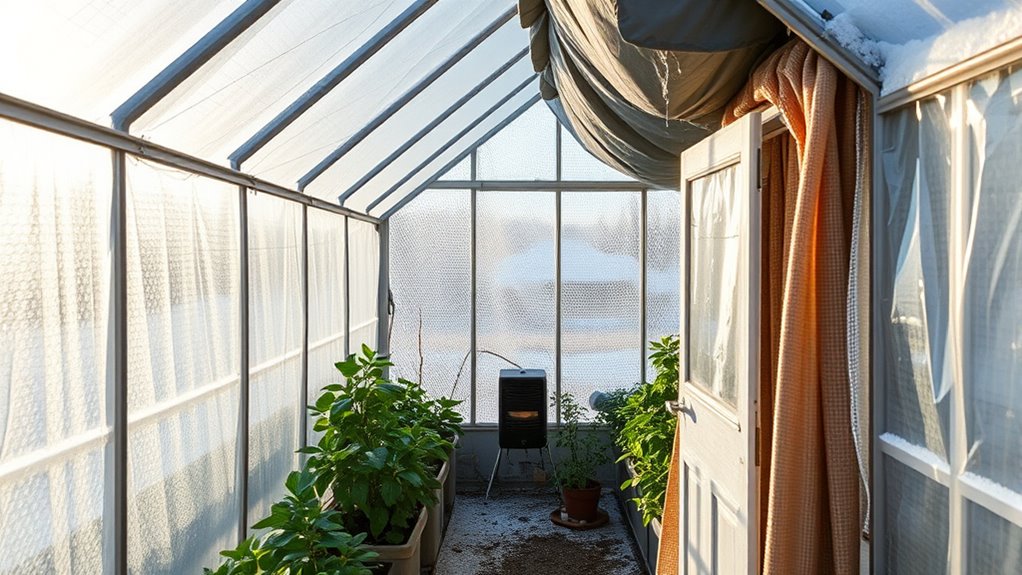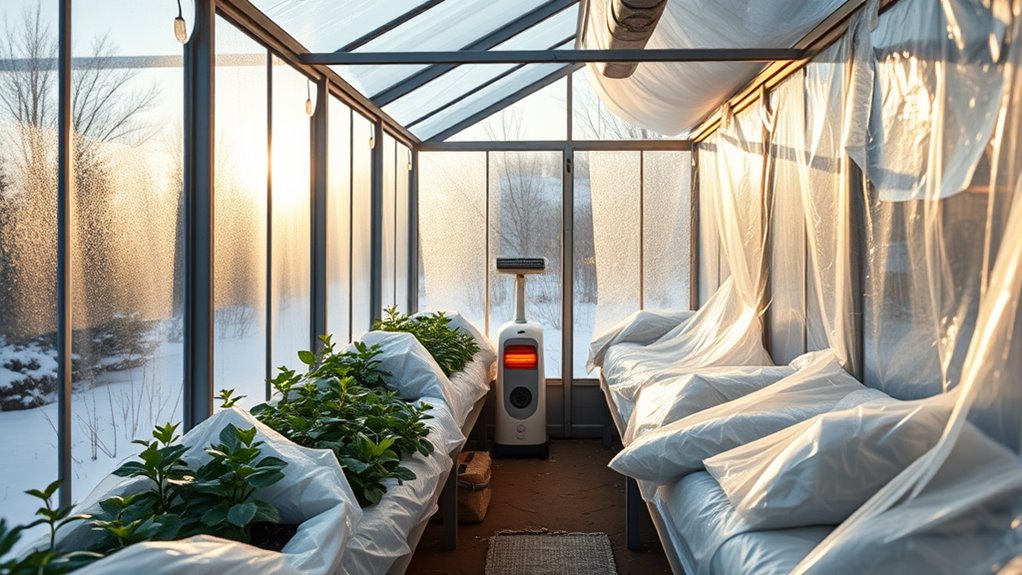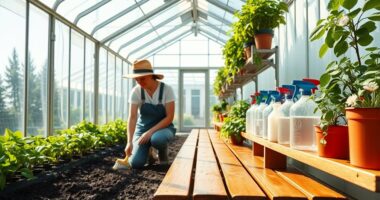To winterize your greenhouse, first seal all gaps and add insulation like bubble wrap to retain heat. Adjust ventilation to prevent excess humidity and cold drafts, using adjustable vents to balance airflow. Insulate watering systems and consider backup heating options to keep temperatures steady. Regularly check seals, monitor temperature and humidity levels, and make adjustments as needed. Want to learn more about keeping your greenhouse warm and healthy throughout winter? Keep exploring for detailed tips.
Key Takeaways
- Seal vents and windows tightly during cold spells to prevent heat loss and cold drafts.
- Insulate greenhouse panels with bubble wrap or thermal covers to retain heat effectively.
- Install backup heating systems and ensure they are functional for consistent warmth.
- Monitor and adjust ventilation to balance airflow and humidity, avoiding stagnation and frost buildup.
- Regularly inspect seals, repairs, and environmental controls to maintain optimal winter conditions.

As winter approaches, it is essential to prepare your greenhouse to withstand colder temperatures and harsh weather conditions. Proper winterization guarantees your plants stay healthy and your structure remains durable throughout the season. One of the most effective ways to do this is by adjusting your ventilation strategies. During winter, you want to balance airflow to prevent excess humidity and condensation, which can promote mold and disease. Consider installing adjustable vents or windows that you can seal tightly during severe cold snaps, but still allow for some air exchange on milder days. Good ventilation helps regulate temperature and humidity levels, reducing the risk of frost and creating a more stable environment for your plants. Additionally, managing airflow prevents stagnant air pockets that can cause problems during winter.
Along with ventilation, watering adjustments play a vital role in winterizing your greenhouse. As temperatures drop, your plants require less water, and overwatering can lead to root rot or fungal issues. You should monitor soil moisture closely, watering only when the soil feels dry to the touch. Use a soil moisture meter if needed to be precise. Reduce the frequency and volume of watering compared to warmer months, but don’t forget that some plants may still need regular hydration to survive the cold. Watering in the early part of the day allows excess moisture to evaporate before evening, decreasing the chance of frost forming on or around your plants. It’s also wise to insulate your watering containers or use heated watering systems if you expect prolonged cold spells. This prevents water from freezing and becoming inaccessible. Incorporating energy-efficient heating options can further help maintain consistent temperatures and reduce energy costs during the winter months.
In addition to ventilation and watering, consider other physical measures such as adding thermal insulation to the greenhouse frame or installing bubble wrap on the interior side of glass or plastic panels. These steps help retain heat and reduce cold drafts. You might also want to install a backup heating system, such as a space heater designed for greenhouse use, to maintain a minimal temperature if outdoor conditions become extremely harsh. Regularly check your greenhouse’s seals and repairs, ensuring there are no gaps that let cold air in or warm air escape. Combining these strategies with vigilant monitoring creates an ideal environment that protects your plants from winter’s worst.
Frequently Asked Questions
Can I Winterize My Greenhouse Without Professional Help?
Yes, you can winterize your greenhouse without professional help. Start with DIY insulation like bubble wrap or thermal blankets to keep the cold out. Perform seasonal maintenance by sealing leaks, inspecting the heating system, and ensuring proper ventilation. These simple steps help protect your plants and extend your growing season. With a bit of effort, you’ll effectively prepare your greenhouse for winter and keep it cozy all season long.
What Materials Are Best for Insulating Greenhouse Windows?
You should use clear plastic sheeting or bubble wrap as insulation materials for your greenhouse windows. These materials act as effective window coverings, trapping heat and reducing cold drafts. You can also consider thermal curtains or weatherproof film for extra insulation. Make sure to secure these coverings tightly to prevent heat loss. This way, your greenhouse stays warmer, protecting your plants during winter’s chill.
How Often Should I Check for Cold Drafts During Winter?
Think of your greenhouse as a cozy cabin; you need to keep it sealed tight. You should check for cold drafts regularly during winter, ideally once a week, to prevent heat loss. Draft monitoring is essential, and you may need to adjust your insulation frequency based on weather changes. Staying vigilant ensures your plants stay warm and healthy, turning your winter greenhouse into a sanctuary against the cold.
Is It Necessary to Heat the Greenhouse During Mild Winter Days?
During mild winter days, heating your greenhouse isn’t always necessary. You should focus on temperature regulation to maintain ideal conditions for your plants. If the temperature stays above your plants’ minimum needs, you can often rely on passive heating methods like insulation and ventilation. However, keep an eye on weather forecasts, and be prepared to provide supplemental heat if temperatures drop unexpectedly, ensuring consistent heating needs are met.
How Do I Prevent Pests From Entering Through Winterized Vents?
To prevent pests from entering through winterized vents, guarantee your ventilation security is tight by installing pest-proof vents with fine mesh screens. Regularly inspect and clean these vents to spot any gaps or damage. Keep vents closed when not needed, especially during cold months, and consider adding weatherproof covers. This approach maintains proper airflow while keeping pests out, protecting your greenhouse plants during winter.
Conclusion
Now that you’ve winterized your greenhouse, you’re practically invincible against the cold! No icy winds or freezing temperatures can stand a chance against your fortress of warmth. Your plants will thrive like never before, turning your greenhouse into a lush, tropical paradise even in the dead of winter. With these tips, you’ve turned your winter worries into a distant memory—your green oasis is now a fortress of summer all year round. Stay warm and keep growing!









